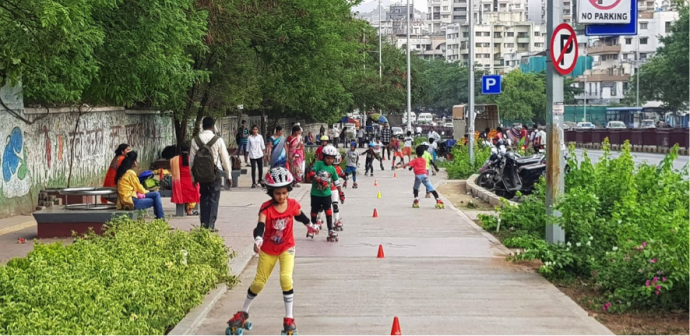how to design accessible & walkable cities in india?

In India, city after city has been focusing on making motorised vehicles the prime focus of transport infrastructure investment. Congestion is deemed undesirable and cities have declared war on it. Road widening, new roads, flyovers and multi-storied parking lots are touted as the panacea for our urban transport woes.
Ahmedabad has recently approved seven more flyovers. The SG road is being widened to six lanes with grade separation at all intersections. Mumbai is going ahead with a coastal road and Bengaluru is pushing for an elevated steel road. Municipal engineers and traffic police are interested in ‘clearing’ roads of traffic in the shortest possible time. Cities are also investing in public transport. BRTS, metro, monorail, electric buses now dot the urban landscape. There is a discussion on investment in hyperloop, metro lite, and similar ideas. Smart cities have infused funds in technology solutions to make our cities liveable. CCTV cameras, Automatic Number Plate Recognition (ANPR), ITMS are part of Central Command Centres (CCC) in many cities.
Mobility vs Accessibility – How far or how many?
Currently, most of the investment in urban transport is for mobility – even in public transport. Thirteen years after the National Urban Transport Policy stated that the focus should be on moving people and not vehicles, the focus firmly remains on moving vehicles. Good examples of moving people and redistributing road space equitably to all road uses are rare. A cursory reading of municipal budgets shows the skew in fund allocation.
Decision-makers, traffic engineers and transport planners need to first get the distinction between mobility and accessibility.
Mobility is how far you can go in a given amount of time. Accessibility is how much you can get to in that time. (www.strongtowns.org)
The point of travel isn’t to cover ground. It is to get us to the things we want to do. It is to get us to our jobs, our friends and families, recreation, and daily needs. Mobility focuses on connecting two points in the fastest way possible. On the other hand, accessibility focuses on how many places could be reached in the shortest time possible. This distinction is at the heart of sustainable planning principles. A mobility-focused approach leads us to cities with dispersed land uses and a need to travel long distances. Accessibility focused approach leads us to cities with mixed land uses and most needs within short distances. It leads to finding solutions for activities such as walking and cycling.
Historically, Indian cities were always ‘accessible’ cities. As cities expanded, the focus shifted to mobility. Go to any Indian city today – flyovers are ubiquitous, an elevated road running through the city centre is common and technology to enable mobility is popular. Transport plans in our cities are called “Comprehensive Mobility Plans” – not “Accessibility Plans”. They focus on road network planning, parking solutions, public transport plans and freight and logistics. They detail out solutions for better mobility along with estimated costs. They talk of accessibility – if at all – sparingly.
Where has this meant for accessibility? As more mobility options get built, accessibility suffers. Trip lengths and trip times increase. The best BRTS in the country – the Ahmedabad BRTS – focuses on moving buses from the station to station swiftly. Ridership has stagnated at 150,000 for the last five years, even as commuters call for better accessibility options to reach homes and workplaces from the BRT stations. Delhi’s metro system has some stations with abysmal pedestrian access. Mobility solutions end at the station. Commuters need to figure out accessibility.

Figure 1: Access below the Delhi metro
Compromising on Safety
The high focus on mobility brings road safety issues. Fatal accidents in Ahmedabad increased from 200 in 2010 to 350 in 2019. Fifty per cent of the people killed are pedestrians. Flyovers mean vehicles speeds have increased. High speed is inversely proportional to road safety as seen in the figure below. As speeds increase beyond 40 km per hour, the chances of survival decrease dramatically.

Figure 2: Speed vs safety / Source: Adapted from WHO
Addition of pedestrian crossings is seen as an impediment to motorised vehicles. Foot overbridges are proposed on busy roads as a ‘safe solution’ for pedestrians. Experience suggests that these foot overbridges are grossly underutilised. They are, in fact, constructed to ensure that vehicles move faster. However, pedestrians prefer crossing at grade. The image below shows just one pedestrian crossing on the bridge while the rest cross at grade in the face of oncoming traffic.

Making a Difference
Some cities have recognised the need to look at accessibility along with mobility. Pune and Mumbai have come out with a ‘pedestrian policy’, which prioritizes pedestrians over vehicles. A dedicated NMT cell nests within the Pune Municipal Corporation headed by an executive engineer. Pune Municipal Corporation has also hired urban designers to help engineers design streets and public spaces. Several km of arterial streets are being redesigned to achieve a better balance between accessibility and mobility.

Figure 4: Accessible streets in Pune | Pic Credit: Nitin Warrier
Chennai has come up with an ambitious plan to revamp over 100 km of its streets. This includes planning and designing street networks in neighbourhoods for accessibility. Coimbatore plans to emulate Chennai. Ahmedabad has begun work to redesign key arterial streets to expand space for pedestrians and slow down motorised traffic through tight turning radius.

Figure 5: Reducing speed through tight turning radius: CG Road Ahmedabad
Source: The Urban Lab, 2019
Kochi is redesigning its arterial streets to ensure a better balance between pedestrians and vehicles. Cities are investing in small urban design solutions to encourage high-quality pedestrian facilities.
Public Bicycle Sharing (PBS) has emerged as another alternative for accessibility and last-mile feeder for public transport. More than fifteen cities in India have installed PBS with varying degrees of success. These systems provide commuters with options for short trips and for last-mile connectivity.
However, much more needs to be done. Discussions about accessibility and walkability need to be mainstreamed in the development process of cities. Urban local bodies need to address accessibility issues by developing visions and policies that support accessibility. They need to follow it up by allotting substantial funds in their budgets for building walking infrastructure and maintaining it. Municipal engineers and traffic police need to be sensitized about the need to take care of pedestrians and cyclists and ensuring their safety.
In the end, as citizens, we need to be clear about what kind of city we aspire for – a ‘mobility’ city with infrastructure for vehicles or an ‘accessible’ city that prioritizes human being.


2 thoughts on “How To Design Accessible & Walkable Cities in India?”